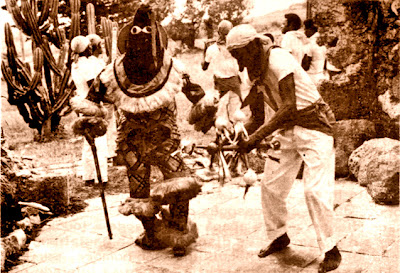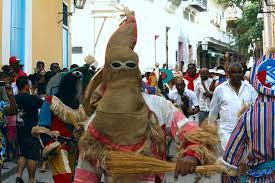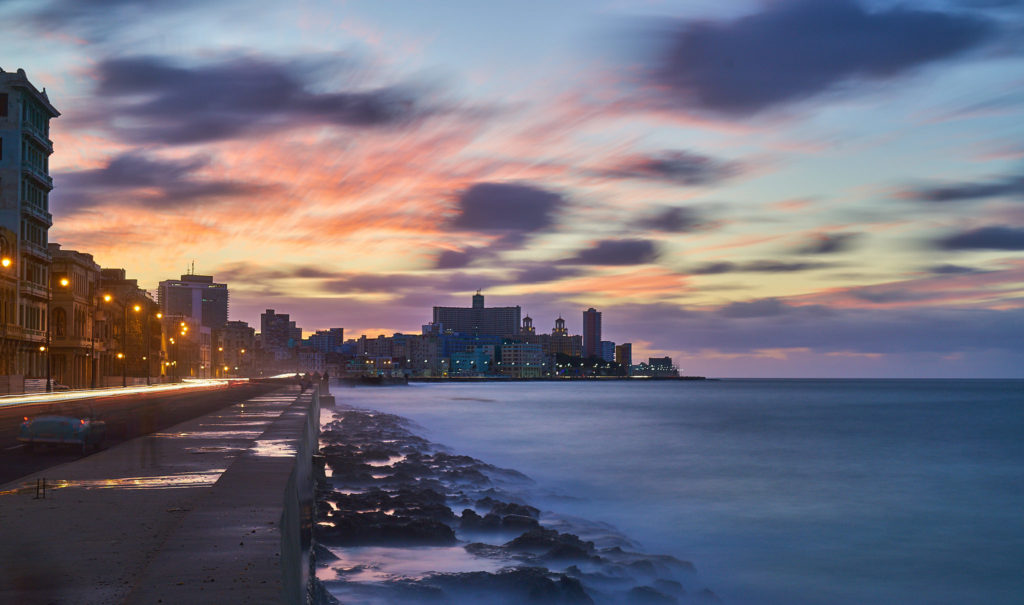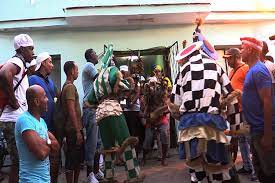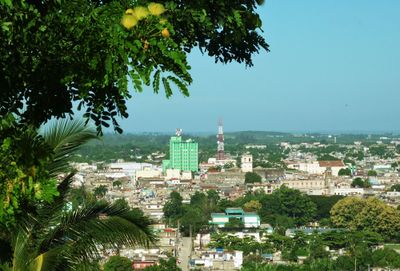ABAKUÁ, también conocido a veces como ñañiguismo, es una fraternidad iniciática o sociedad secreta de hombres afrocubanos, que se originó a partir de asociaciones fraternales en la región de Cross River en el sureste de Nigeria y el suroeste de Camerún.
Abakuá ha sido descrito como “una versión afrocubana de la masonería”.
Los miembros de esta sociedad llegaron a ser conocidos como ñañigos, palabra utilizada para designar a los bailarines callejeros de la sociedad. Los ñañigos, también llamados diablitos, eran bien conocidos por la población en general en Cuba a través de su participación en el Carnaval del Día de los Reyes Magos, cuando bailaban por las calles ataviados con su traje de ceremonia, un traje damero multicolor con forma cónica, tocado rematado con borlas.
Los juramentos de lealtad a los objetos sagrados, miembros y conocimientos secretos de la sociedad abakuá que toman los iniciados son un pacto de por vida que crea un parentesco sagrado entre los miembros. Los deberes de un miembro abakuá para con sus hermanos rituales a veces superan incluso las responsabilidades de la amistad, y a menudo se escucha la frase “La amistad es una cosa y los abakuá otra”. Uno de los juramentos que se hacen durante la iniciación es que no se revelarán los secretos de los abakuá a los no miembros, razón por la cual los abakuá se han mantenido herméticos por más de 160 años.
CEREMONIA
Además de actuar como una sociedad de ayuda mutua, los abakuá realizan rituales y ceremonias, llamados plantes, llenos de teatralidad y dramatismo que consisten en tocar tambores, bailar y cantar en la lengua secreta abakuá. El conocimiento de los cantos está restringido a los miembros abakuá, pero los eruditos cubanos han pensado durante mucho tiempo que las ceremonias expresan la historia cultural abakuá. Otras ceremonias como iniciaciones y funerales, son secretas y ocurren en el salón sagrado del templo abakuá, llamado la famba.
MUSICA
La música rítmica bailable de los abakuá combinada con las tradiciones bantúes del Congo contribuyeron a la tradición musical de la rumba.
Aunque hermético y poco conocido incluso dentro de Cuba, un análisis de la música popular cubana registrada desde la década de 1920 hasta el presente revela la influencia abakuá en casi todos los géneros de la música popular cubana. Los músicos cubanos que son miembros de Abakuá han documentado continuamente aspectos clave de la historia de su sociedad en grabaciones comerciales, generalmente en su idioma secreto Abakuá. Los abakuá han grabado comercialmente cantos reales de la sociedad, creyendo que los extraños no pueden interpretarlos. Debido a que Abakuá representó un aspecto rebelde, incluso anticolonial, de la cultura cubana, estas grabaciones secretas han sido muy populares.
BAILARINES
Ireme es el término cubano para el bailarín abakuá enmascarado conocido como Idem o Ndem en la región de Cross River. El bailarín de disfraces está cuidadosamente cubierto con un traje ajustado y una capucha, y baila con una escoba y un bastón. La escoba sirve para limpiar a los fieles, mientras que el bastón castiga a los enemigos y traidores abakuá. Durante las ceremonias de iniciación, el bastón se denomina Erí nBan nDó, mientras que durante los duelos y velatorios se denomina AlanManguín Besuá.
RELIGION
Los miembros Abakuá derivan sus sistemas de creencias y prácticas tradicionales de los espíritus Efik, Efut, Ibibio Igbo y Bahumono que vivían en el bosque. Ekpe y los términos sinónimos eran nombres tanto de un espíritu del bosque como de una sociedad secreta relacionada con el leopardo. Gran parte de lo que creen los abakuá en términos de religión se considera un secreto que solo conocen los miembros.
LA SANTERIA EN LA VIEJA HABANA…
En La Habana hay algunos sitios ligados a la santería y las religiones africanas de visita casi obligada. Por ejemplo, el Callejón de Hamel, donde además de vistosos murales callejeros y psicodélicas tiendas de arte se encuentra el templo supremo de la cultura afrocubana del Centro Habana.
Hay otras dos referencias habaneras más que nos llevarán al mundo de la santería: uno es Regla, un barrio al otro lado del puerto, frente a la Habana vieja, cuya popular iglesia está siempre abarrotada tanto de devotos católicos como de otras tradiciones africanas.
El otro punto de obligada visita es Guanabacoa, un pequeño municipio engullido por la gran ciudad que sin embargo conserva un aire algo bucólico de pueblo pequeño. Los autóctonos lo llaman el pueblo embrujado por sus fuertes tradiciones santeras, aunque también hay conexiones indígenas. Podemos, por ejemplo, ir a comer al Centro Cultural Recreativo los Orishas, donde muchos fines de semana ofrecen rumba en directo y una buena selección de comida en un jardín rodeado de estatuas de deidades de la santería.
En Santiago podemos conocer también los secretos del Palo Monte, culto diferente a la santería, pues mientras que esta gira en torno a sus deidades, el Palo Monte rinde culto a los ancestros y a la creencia en poderes terrenales naturales, como el agua, las montañas y sobre todo, los palos. El viajero sabrá que está en un templo dedicado al Palo Monte cuando vea en el altar un caldero repleto de palos, piedras y huesos de difuntos, a menudo con un crucifijo encima.
Sus bastiones son Santiago de Cuba, Regla y Guanabacoa, Matanzas, Bahía Honda y Palmira (Cienfuegos).
CUBA, “ÑAÑIGUISM” AND THE AFRO-CUBAN SECRETS OF THE ABAKUÁ CULT. PHOTOS
Abakuá, also sometimes known as ñañiguismo, is an initiatory fraternity or secret society of Afro-Cuban men, which originated from fraternal associations in the Cross River region of southeastern Nigeria and southwestern Cameroon.
Abakuá has been described as “an Afro-Cuban version of Freemasonry”.
The members of this society became known as ñañigos, a word used to designate the street dancers of the society. The ñañigos, also called little devils, were well known by the general population in Cuba through their participation in the Three Kings Day Carnival, when they danced through the streets dressed in their ceremonial costume, a multi-colored checkerboard suit-shaped conical, headdress topped with tassels.
The oaths of allegiance to the sacred objects, members, and secret knowledge of Abakuá society taken by initiates are a lifelong pact that creates a sacred kinship between members. An Abakuá member’s duties to his ritual brothers sometimes outweigh even the responsibilities of friendship, and the phrase “Friendship is one thing and the Abakuá another” is often heard. One of the oaths taken during initiation is that Abakuá secrets will not be revealed to non-members, which is why the Abakuá have remained secretive for more than 160 years.
CEREMONY
In addition to acting as a mutual aid society, the Abakuá perform rituals and ceremonies, called plates, full of theatrics and drama that consist of drumming, dancing, and singing in the secret Abakuá language. Knowledge of the songs is restricted to Abakuá members, but Cuban scholars have long thought that the ceremonies express Abakuá’s cultural history. Other ceremonies, such as initiations and funerals, are secret and take place in the sacred hall of the Abakuá temple, called the famba.
MUSIC
The rhythmic dance music of the Abakuá combined with the Bantu traditions of the Congo contributed to the musical tradition of the rumba.
Though hermetic and little known even within Cuba, an analysis of recorded Cuban popular music from the 1920s to the present reveals Abakuá’s influence in nearly every genre of Cuban popular music. Cuban musicians who are members of the Abakuá have continually documented key aspects of their society’s history on commercial recordings, usually in their secret Abakuá language. The Abakuá have commercially recorded actual songs from society, believing that outsiders cannot perform them. Because Abakuá represented a rebellious, even anti-colonial aspect of Cuban culture, these secret recordings have been very popular.
DANCERS
Ireme is the Cuban term for the masked Abakuá dancer known as Idem or Ndem in the Cross River region. The costume dancer is neatly covered in a tight-fitting suit and hood, and dances with a broom and cane. The broom is used to cleanse the faithful, while the staff punishes Abakuá enemies and traitors. During initiation ceremonies, the staff is called Erí nBan nDó, while during duels and wakes it is called AlanManguín Besuá.
RELIGION
Abakuá members derive their belief systems and traditional practices from the Efik, Efut, Ibibio Igbo, and Bahumono spirits who lived in the forest. Ekpe and the synonymous terms were names of both a forest spirit and a leopard-related secret society. Much of what the Abakuá believe in terms of religion is considered a secret and is known only to members.
SANTERIA IN OLD HAVANA…
In Havana, there are some sites linked to Santeria and African religions that are almost a must. For example, the Callejón de Hamel, where, in addition to colorful street murals and psychedelic art shops, is the supreme temple of Afro-Cuban culture in Centro Habana.
There are two other Havana references that will take us to the world of Santeria: one is Regla, a neighborhood on the other side of the port, opposite Old Havana, whose popular church is always packed with both devout Catholics and other African traditions.
The other point of obligatory visit is Guanabacoa, a small municipality engulfed by the big city that nevertheless retains a somewhat bucolic air of a small town. The natives call it the haunted town for its strong santera traditions, although there are also indigenous connections. We can, for example, go to eat at the Los Orishas Recreational Cultural Center, where many weekends they offer live rumba and a good selection of food in a garden surrounded by statues of Santeria deities.
In Santiago we can also discover the secrets of Palo Monte, a cult different from Santeria, because while it revolves around its deities, Palo Monte worships the ancestors and the belief in natural earthly powers, such as water, mountains, and above all, the sticks. The traveler will know that he is in a temple dedicated to Palo Monte when he sees on the altar a cauldron full of sticks, stones, and bones of the deceased, often with a crucifix on top.
Its strongholds are Santiago de Cuba, Regla, Guanabacoa, Matanzas, Bahía Honda, and Palmira (Cienfuegos).
Agencies/ Wiki/ ElPais/ AbakuaHist./ Extractos/ Excerpts/ Internet Photos/ Arnoldo Varona/ www.TheCubanHistory.com
THE CUBAN HISTORY, HOLLYWOOD.



